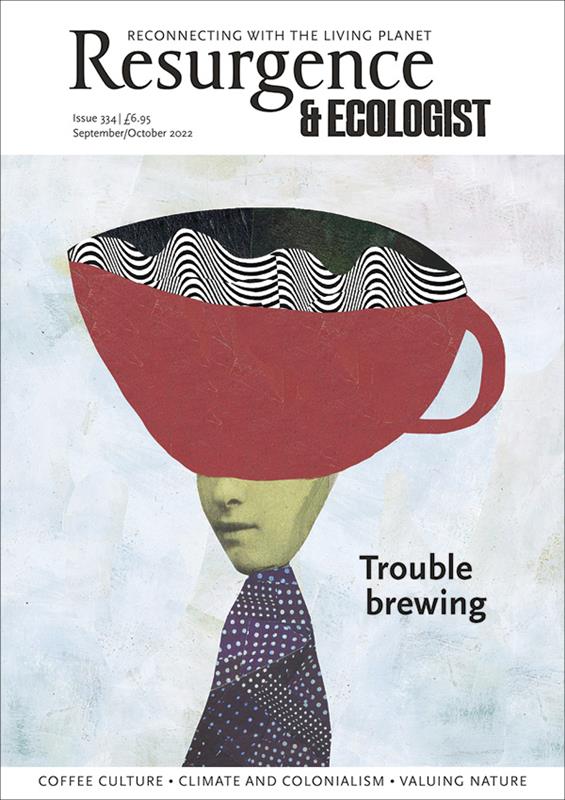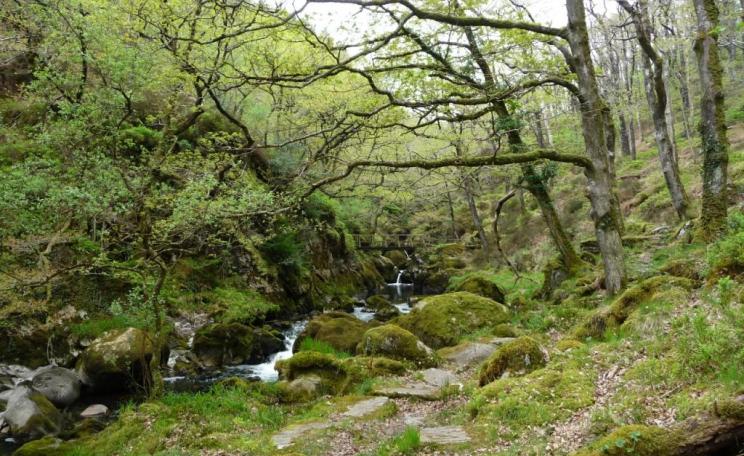If we manage to balance wild prey and predators, there won’t be a problem with coexistence
On a clear day, the view from the mountain peak of Serra de Montemuro in northern Portugal is breathtaking.
“We have a 360-degree view and can watch over an area of about 10,000 hectares,” explains Miguel Pontes.
This article first appeared in the latest issue of the Resurgence & Ecologist magazine. Find out more.
Pontes and his colleague Gonçalo Matos form the surveillance team of the conservation group Rewilding Portugal. Sitting on their motorbikes, they watch for signs of fires on the vast horizon.
Crimes
If there is any suspicious smoke, they drive there to check and will alert the fire brigades if needed. “During the summertime, we focus on forest fires. The rest of the year we investigate environmental and wildlife crimes, ranging from poaching to waste dumping,” Pontes says.
Their work is one of nine projects in the portfolio of Rewilding Europe, an initiative that was started in 2011 in the Netherlands using private and public funding.
The aim is to restore nature and bring back species that have disappeared from the landscapes of the continent and stabilise the ones that still exist in fragmented populations.
The group is busy creating a 120,000-hectare corridor joining the Douro River in the north with the Malcata Mountains in the south by following the Côa River and its tributaries.
Marginal
The conservationists want the valley to reclaim its ecological functions of the past, for instance as a passageway for migrating red and roe deer, ibex and eventually even Iberian wolf and lynx.
“For that, we identified seven core areas, for which we are busy acquiring land ownership,” explains Rewilding team leader Pedro Prata.
While in these seven core areas the protection of nature and wildlife will be the main focus, in other areas of the corridor the initiative endeavours to kick-start a nature-based economy.
“The core areas are marginal lands with no real farming potential or value. Whenever there is active land, we don’t buy it, but rather support the continuation of the farming there and advise the owners on more nature-friendly practices,” Prata says.
Alternatives
As we leave the central Côa valley and head north on the national roads towards the Douro and its wineries, the scenery outside Prata’s car window is starting to change.
Barren terraces on the slopes have been turned into fruit orchards: apple, pear, quince, almond.
This is where the effects of a revised Common Agricultural Policy (CAP) by the European Union since 2018 can be seen with the naked eye.
If we manage to balance wild prey and predators, there won’t be a problem with coexistence
Policies that were supposed to counter rural abandonment and benefit nature have been turned on their heads, in the opinion of activists and some experts.
EU subsidies were for instance offered to support “sectors at risk of abandonment or with no cultivation alternatives”.
Incentives
Soon people figured out how to maximise the subsidy payment rather than trying to follow the spirit of the directives from Brussels.
“Look, that’s an orchard. That can receive a pollinator scheme payment. As you can see, there’s not a single flower there!” exclaims a visibly upset Prata, pointing out of the car window.
“This can get a subsidy of up to €900 per hectare per year. Over here,” he says, indicating the other side of the road, “there is bushland with plenty of flowers, not entitled to payments.”
Overall, the Portuguese Rural Development Programme, which provides a national interpretation of the CAP, provides the farmers of the country with incentives worth €8 billion.
Purpose
To access them, farmers burn shrublands to clear them for the orchards or plough them, releasing carbon emissions. Orchards blossom once a year, not, therefore, offering much advantage to pollinators like bees.
“Even though CAP has also a declared goal to restore European nature and landscapes, it is not fit for purpose,” Prata says.
Mariano Recio of the Biodiversity and Conservation Unit of King Juan Carlos University in Madrid agrees: “Most agricultural practices in the Iberian Peninsula are ruled by what type of crops or uses are subsidised (or not) in each of the CAP funding periods.
This can result in crops that are not even harvested or can be over-planted in order to maximise the benefit from subsidies.”
Traditional
Research that Recio published with his colleague Emilio Virgos in 2020 found that CAP and Rewilding initiatives all over Europe are at odds, even though “they could and should be

complementary, especially since they are both supported by the EU.”
Virgos and Recio see in particular a conflict caused by the ambitions of rewilding groups not only to bring back large herbivores but also to boost the dwindling numbers of predators in these regions.
“The current CAP is subsidising extensive livestock farming practices in many marginal mountain and mid-mountain areas.
This strategy allows livestock heads to increase above the numbers that historically existed under traditional practices in these areas,” says Recio.
Wolves
Although these CAP incentives may increase economic profits and favour the rural people to remain, this “clashes with the arrival of large predators, such as the wolf, the brown bear or the Eurasian lynx”, state Virgos and Recio.
While wineries and orchards dominate the agriculture around the Douro, to the south the CAP incentives have led to ever-expanding areas of cattle grazing, with herds often not even being behind fences.
They become too-easy prey for opportunistic wolves, leading to a large increase in attacks in the Côa Valley between 2012 and 2016.
Local farmers complained that government compensation for damages suffered during the attacks was not adequate. They took matters into their own hands, and stable packs of wolves disappeared from the valley again.
Fencing
Cattle rancher Rui Matos had the first wolf attack at his farm Quinta do Tabalião in 2014. “A little calf was killed. It was worth €500, but I had to wait over a year for government compensation and eventually got about half of that value,” Matos says, shaking his head.
As head of the local cattle breeder association, it became clear that he had to invest in better protection.
“When Rewilding Portugal got established in 2019, I was one of the first ranchers they contacted to establish a partnership,” Matos recalls. He says that their ideas helped, and points to his guard dog Hati as an example.
Hati is one of 52 guard dogs integrated by Rewilding Portugal to work on the farms of the valley. The dog programme, along with other measures such as advice and financial support for fencing, forms the core of Rewilding’s effort to further reduce human-wolf conflict – “to help with the adoption of effective measures to prevent attacks and to promote the abundance of wild prey”.
Fair
The Rewilding team, Matos and other farmers of the region agree on one important point, and that is that politics needs to keep up and not leave the people of the region to fend for themselves.
When asked if he would feel comfortable with an established wolf pack near his ranch, Matos replies: “If there was fair and quick compensation for attacks, yes. But as things stand, the farmers here would have problems with that because they have to carry all the damages and costs related to it.”
Nonetheless, Matos feels confident that “if we manage to balance wild prey and predators, there won’t be a problem with coexistence.”
This author
Roman Goergen is a freelance journalist based in London. This article first appeared in the Resurgence & Ecologist magazine, which focuses on coffee culture. You can buy this issue here.




